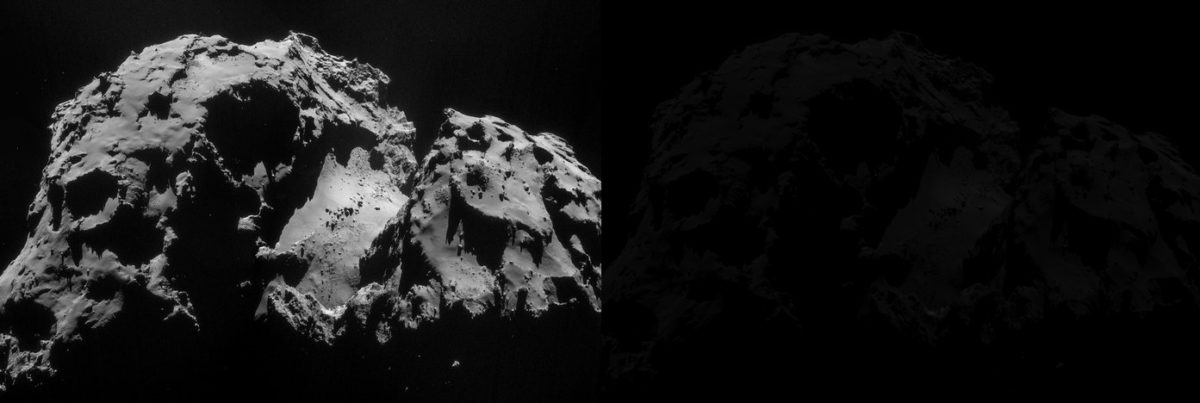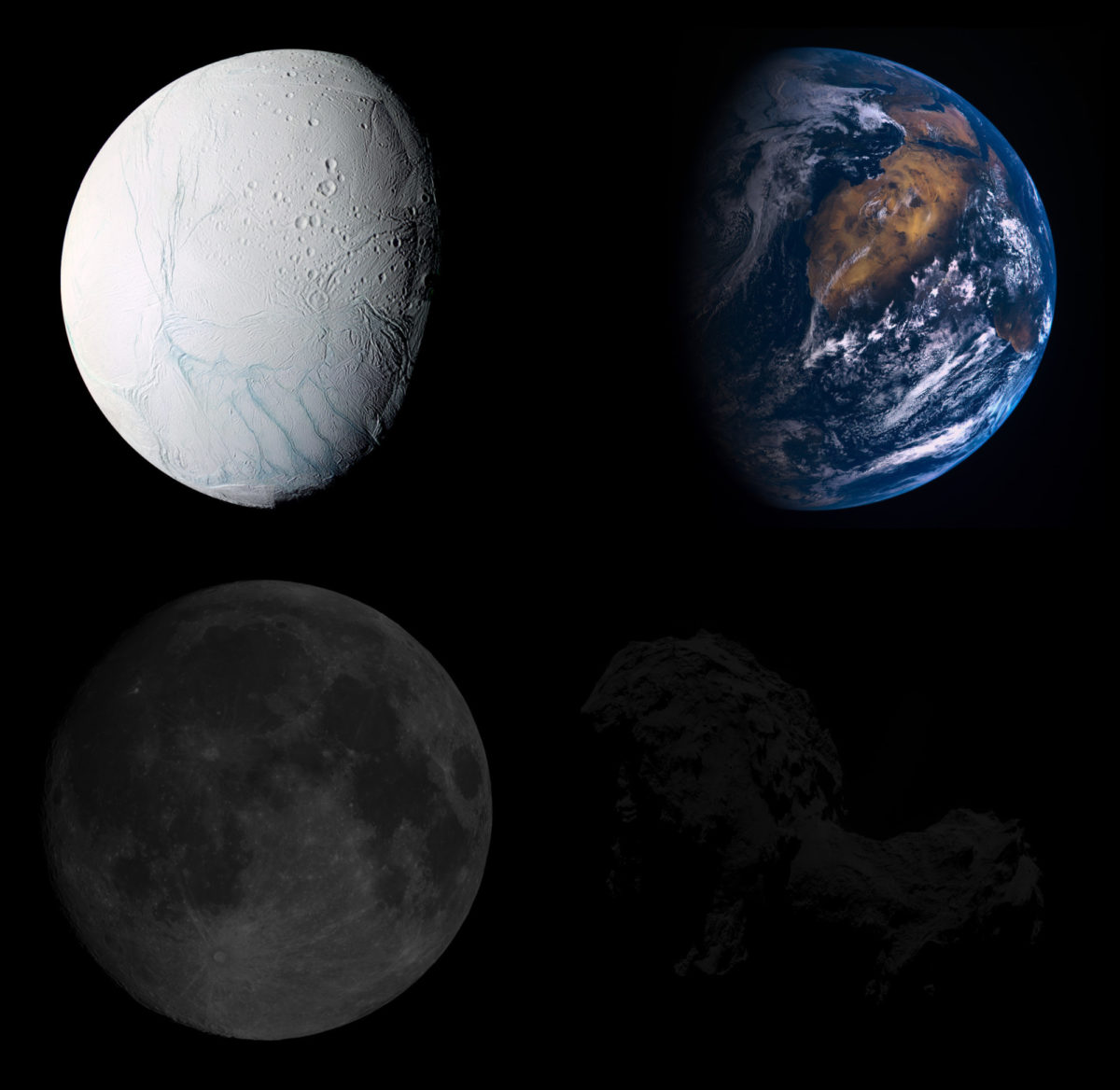Claudia Mignone • Oct 27, 2014
Rosetta NAVCAM's Shades of Grey
This article was compiled and edited by Claudia Mignone, science writer for ESA, with contributions from Mark McCaughrean, Senior Science Advisor at ESA. It originally appeared at the Rosetta blog and is reposted here with permission.
Ever since early August, when Rosetta rendezvoused with Comet 67P/Churyumov-Gerasimenko at a distance of roughly 100 km, the on-board navigation camera (NAVCAM) has been returning images that depict the many different facets of its nucleus. A complex surface emerges from these images, revealing valleys, cliffs, boulders, and craters all over the comet.
NAVCAM takes black-and-white images and the surface of 67P/C-G shows a wide dynamic range of light and dark regions, depending on the illumination conditions and surface characteristics at any given area. But what do “light” and “dark” mean for an object like 67P/C-G? Followers of this blog have asked this and similar questions, so here are some details on how NAVCAM images are taken and displayed to make a wide range of surface features possible.

So combining these two facts, there’s not that much light coming from 67P/C-G with which to take a picture. But just as you would do in dimly lit situations on Earth, that can be overcome by using a longer exposure time. In particular, the exposure time needs to be long enough to get above the background noise of the detector, but not so long that any parts of the scene saturate the detector. With NAVCAM, the aim is to get the brightest parts of the comet up to roughly 75–85% of the detector saturation limit, which at present means an exposure time of 6 seconds.
Once a NAVCAM image has been captured and sent back to Earth, it is processed to remove artefacts due to electronic noise. The data are then scaled for display according to their brightness: if left untouched, the darkest parts in the image, where there is essentially no light, will be black, while the brightest parts will be at about 75–85% grey (where 100% grey is white). In practice, some slight additional tweaking of the brightness and contrast is done to bring out the full range of features, with the result that the brightest parts of the nucleus are just about white.
While this is a perfectly standard approach, it admittedly doesn’t give a completely accurate impression of the physical nature of the comet, where even the white parts of the picture are in fact very dark.
But actually, the human eye and brain do this all the time, constantly adjusting their sensitivity and perception of intensities to the scene at hand or even locally within a given scene. This so-called “anchoring” effect is the reason why the Moon appears white or even to shine against the dark night sky, while we know – not least from photos shot by moonwalking astronauts, as well as direct measurements of samples of the lunar soil – that the Moon’s surface is in fact a dark shade of grey, with an average albedo of around 12%.

So, a human in a spaceship next to 67P/C-G may in fact perceive the comet pretty much as it is seen in the intensity-stretched NAVCAM images, if not even brighter. But one way of giving at least a suggestion of just how dark comets are is to show 67P/C-G against a number of other Solar System objects exhibiting a wide range of albedos.
The montage below compares 67P/C-G with the Moon, the Earth, and Enceladus, a moon of Saturn. The brightness of each object in the montage has been scaled according to its mean albedo: for 67P/C-G, we have taken an albedo of 5%; for the Moon, 12%; for Earth, 31% (with deserts having an albedo of roughly 40%, thin clouds 30–50%, thick clouds 60–90%, and oceans 7–10%). Finally, for simplicity, an albedo of 100% has been taken for the brightest parts of the ice-covered surface of Enceladus, the most reflective body in the Solar System.
It’s hard to do this scientifically accurately, partly because the actual albedo in a given image of an object depends on a whole host of factors and because the human eye and brain don’t respond linearly to different light levels. But hopefully this comparison gives at least an impression of quite how dark 67P/C-G is and how diverse the Solar System’s bodies can be.

Beyond the overall darkness of 67P/C-G, why are some regions nevertheless lighter and darker than the average? Some of this will likely be due to compositional differences across the surface of the comet, with some regions fresher due to activity and others more deeply covered in dust. The Rosetta scientists are studying the composition of the surface through a combination of imaging at different ultraviolet, visible, infrared, and millimetre wavelengths, along with a range of other remote-sensing diagnostics.
But one key difference is down to the angle between the incident sunlight hitting the comet and the reflected light being measured by Rosetta, which scientists call the ‘phase angle’. When the phase angle is large, the spacecraft sees shadows cast over the surface by the light coming in at an angle, but when the phase angle is small, few shadows are seen.

A particular effect occurs on many airless bodies in the Solar System whose surfaces are covered in dust, including the Moon, asteroids, and comets, when the phase angle reaches zero: with the light coming from behind the observer, a significant brightening is seen, the so-called ‘opposition surge’. This is in part due to the fact that, under these conditions, there are no shadows visible anymore: they are all ‘hidden’ behind the objects (e.g. dust particles and rocks) being illuminated, as seen from the observer. Another effect may occur if the dust particles are roughly the same size as the wavelength of light being measured: this can result in them acting as little retro-reflectors, again causing an increase in brightness at zero phase angle.
Thus, despite the very dark nature of the comet, there is nevertheless much to be learned about its surface structure and composition from observing the small differences in that reflected light, even if it is very faint. Results are expected over the coming months as the scientists analyse the data being collected at this enigmatic body, 67P/C-G.
Support our core enterprises
Your support powers our mission to explore worlds, find life, and defend Earth. You make all the difference when you make a gift. Give today!
Donate

 Explore Worlds
Explore Worlds Find Life
Find Life Defend Earth
Defend Earth

